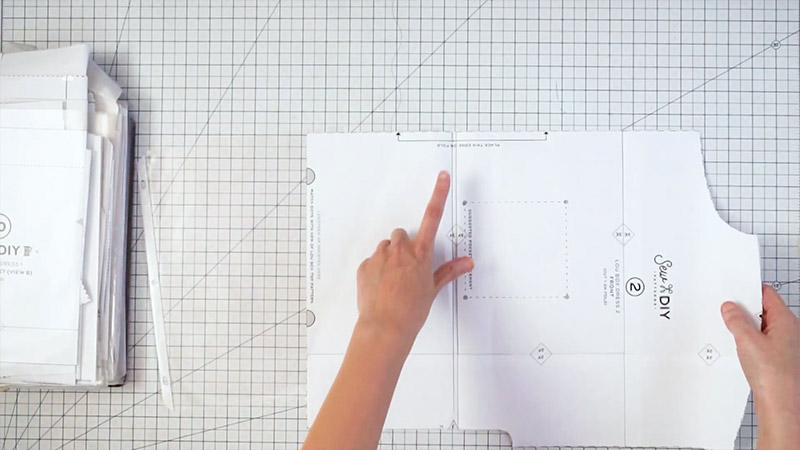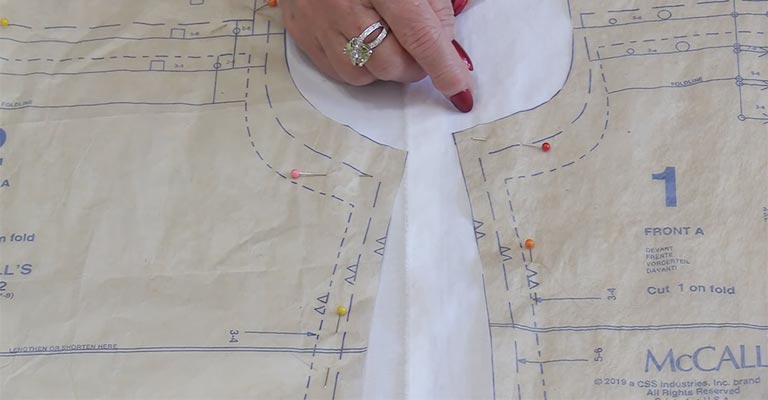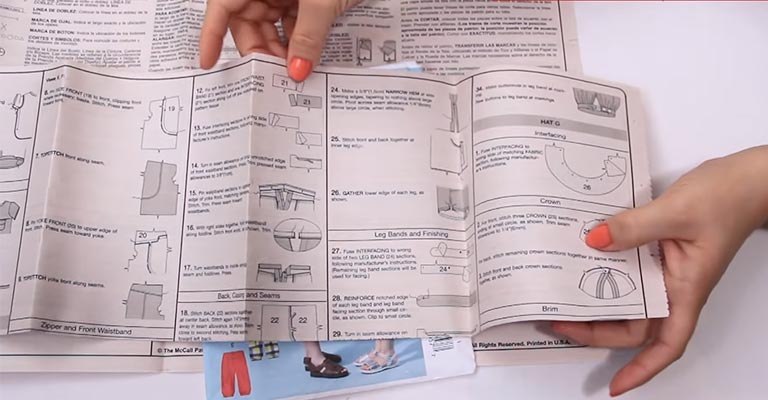The world of sewing has undergone a remarkable transformation, thanks to an ingenious invention that forever changed the way garments are made.
In the mid-19th century, a visionary named Ebenezer Butterick introduced a revolutionary concept that would democratize sewing and empower individuals to create their own clothing. The innovation? The first perforated sewing patterns.
These meticulously designed templates, with their small holes and notches, provided clear and consistent guidance for cutting fabric, sewing seams, and folding material.
In this exploration of the history and significance of the first perforated sewing patterns, we delve into the origins of this game-changing concept and its enduring impact on the art of garment-making.

History of Perforated Sewing Patterns
The history of perforated sewing patterns is a fascinating journey that transformed the art of sewing and made it more accessible to a broader audience.
Here’s an overview of the history of these patterns:
Before Perforated Patterns
Before the introduction of perforated patterns, sewing was a labor-intensive and highly skilled craft. Patterns were often traced onto fabric by hand, and cutting out the pieces required meticulous attention to detail.
Ebenezer Butterick and the Invention (1863)
The credit for introducing the first commercial perforated sewing patterns goes to Ebenezer Butterick. In 1863, he developed a method of creating sewing patterns by perforating tissue paper with small holes or notches.
These perforations were strategically placed along the lines and edges of pattern pieces, serving as guides for cutting fabric and sewing seams.
Simplifying Sewing
The introduction of perforated patterns simplified the sewing process significantly. Now, even individuals with limited sewing skills can follow the clear guidelines provided by these patterns.
They eliminated the need for manual tracing and allowed for more precise and efficient garment-making.
Democratizing Sewing
Perforated sewing patterns played a pivotal role in democratizing sewing. They made the craft accessible to a wider audience, empowering both novices and experienced seamstresses to create garments with greater ease and precision.
The Evolution of Perforated Patterns
Early perforated patterns lacked printed markings and seam allowances. Users had to rely on their own knowledge or provide written instructions.
Over time, patterns evolved to include printed guidelines, providing sewers with additional convenience.
Impact on the Sewing Industry
Perforated patterns had a profound impact on the sewing industry. They contributed to its growth and development, as more people engaged in sewing as a hobby or profession.
The accessibility and convenience of perforated patterns transformed the landscape of home sewing and fashion.
Continued Relevance
Perforated sewing patterns have continued to evolve and adapt to the needs of modern sewers. They are available in various formats today, from traditional paper patterns to digital downloads, offering a high degree of flexibility and customization for creating clothing and accessories.
What Was The First Perforated Sewing Patterns?

The first perforated sewing patterns were introduced in 1863 by Ebenezer Butterick. Before their advent, sewing patterns were laboriously traced onto fabric and cut by hand, requiring significant skill.
Butterick’s innovation involved perforating tissue paper with small holes or notches along specific lines and edges, simplifying the cutting, sewing, and folding processes.
These patterns democratized sewing, making it accessible to a wider audience, from novices to experienced seamstresses.
Over time, they evolved to include printed markings and seam allowances, further enhancing precision. Ebenezer Butterick’s groundbreaking introduction of perforated sewing patterns revolutionized the art of garment-making and laid the foundation for the modern sewing industry.
What Was the Significance of Perforated Patterns in Sewing?

The significance of perforated patterns in sewing is multifaceted and profound. These patterns, which were introduced in the 19th century, revolutionized the world of sewing in several ways:
Accessibility
Perforated patterns made sewing accessible to a broader audience. They simplified the sewing process, enabling both novices and experienced seamstresses to create garments with greater ease and precision. This democratization of sewing allowed more people to engage in the craft.
Precision and Consistency
The small holes and notches on perforated patterns provided clear, consistent guidelines for cutting fabric, sewing seams, and folding material. This precision ensured that garments were well-fitted and free from errors, even for those with limited experience.
Time Efficiency
Perforated patterns significantly reduced the time and effort required to prepare fabric pieces. Traditional methods of tracing and cutting patterns by hand were time-consuming and often error-prone. With perforated patterns, sewers could start stitching more quickly, streamlining the process.
Standardization
These patterns introduced a level of standardization in garment-making. Multiple copies of the same pattern would yield uniform results, crucial for both home sewers and mass production in the fashion industry.
Empowerment
Perforated patterns empowered individuals to create their own clothing, reducing the need for expensive tailor-made garments. This empowerment allowed for self-expression through fashion, marking a shift in how people dressed and perceived clothing.
Sewing Industry Growth
The widespread use of perforated patterns led to an increase in the demand for sewing machines, fabrics, and related sewing products. This, in turn, contributed to the growth of the sewing industry, making it a more significant part of the economy.
How Have Sewing Patterns Evolved Since the Introduction of Perforated Patterns?

Since the introduction of perforated sewing patterns in the 19th century, sewing patterns have undergone significant evolution to meet the changing needs and preferences of sewers.
Here’s how they have evolved:
Printed Markings and Seam Allowances
One of the most significant developments is the inclusion of printed markings and seam allowances on sewing patterns. Early perforated patterns often lacked these, requiring sewers to rely on written instructions or their own knowledge.
The addition of printed guidelines greatly simplified the sewing process and reduced the potential for errors.
Advanced Sizing
Modern sewing patterns now offer a broader range of sizes, including plus sizes, petite sizes, and options for various body shapes. This inclusivity allows sewers to choose patterns that align with their individual measurements, resulting in better-fitting garments.
Customization Options
Many contemporary sewing patterns incorporate customization options. Seamstresses can adjust patterns to fit their specific body measurements, accommodating unique preferences and ensuring a personalized final product.
Specialized Patterns
The range of available patterns has expanded to cover a wide array of garment types and sewing techniques. Sewers can find patterns for everything from dresses and tops to swimwear, outerwear, and even costumes.
This diversity allows for greater creativity and specialization.
Digital Sewing Patterns
The digital age has introduced digital sewing patterns, which can be purchased online, downloaded, and printed at home. These patterns often come with detailed instructions and may include video tutorials, enhancing convenience and accessibility for sewers.
Online Sewing Communities and Resources
The internet has given rise to extensive online sewing communities, blogs, forums, and video platforms where sewers can share experiences, tips, and tutorials related to using sewing patterns. These resources provide valuable support and inspiration.
Sustainability and Eco-Friendly Patterns
There’s a growing emphasis on sustainability and eco-friendly practices in the sewing world. Some pattern companies focus on creating patterns that encourage the use of upcycled fabrics or the reduction of environmental impact, aligning with the broader sustainability movement.
Inclusive Representation
Sewing patterns now often feature models of various ethnicities, sizes, and gender identities, promoting a more inclusive and diverse approach to fashion and sewing.
Incorporation of Technology
Some sewing patterns have started to incorporate technology, such as QR codes that link to instructional videos or companion apps that assist with pattern assembly, customization, and project tracking.
Digital Fabric Cutting and Printing
Advancements in technology have made it possible to print sewing patterns directly onto fabric or use digital cutting machines to precisely cut fabric pieces, streamlining and automating the sewing process.
FAQs
What Are Perforated Sewing Patterns?
Perforated sewing patterns are templates with small holes or notches that guide fabric cutting, sewing, and folding, simplifying the garment-making process for sewers.
Who Invented the First Perforated Sewing Patterns?
Ebenezer Butterick invented the first perforated sewing patterns in 1863, introducing a revolutionary concept that simplified garment-making and democratized sewing.
Where Can You Find Vintage Perforated Sewing Patterns?
Vintage perforated sewing patterns can be found in antique stores, online marketplaces like eBay, and through collectors and sewing enthusiasts who often share or sell them.
Why Do Perforated Sewing Patterns Continue to Be Relevant in Modern Sewing?
Perforated sewing patterns remain relevant in modern sewing due to their precision, accessibility, and adaptability, offering a timeless and dependable resource for creating garments and accessories.
What Are Some Interesting Sewing Projects You Can Create with Perforated Patterns?
Perforated patterns enable a wide range of creative sewing projects, from garments like dresses and tops to accessories like bags and hats, as well as home decor items like curtains and cushions.
To Recap
In the world of sewing, the introduction of the first perforated patterns by Ebenezer Butterick in 1863 marked a turning point that forever changed the art of garment-making.
These small holes and notches simplified the sewing process, making it accessible to a wider audience and empowering individuals to create their own clothing.
The legacy of perforated sewing patterns endures in the modern sewing industry, where they continue to provide clear and precise guidance.
As we conclude our exploration of this transformative invention, we recognize its profound impact on the sewing world, from democratizing sewing to standardizing the craft and fostering a culture of creativity and self-expression through fashion.
Leave a Reply